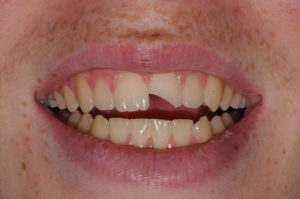What to Do When Your Child is Injured in the Mouth
 Kids are pretty accident-prone. From taking their first little baby steps to leaning to ride a bicycle to playing sports, they have a high risk of injuring themselves. Often these injuries affect the face, mouth, and teeth.
Kids are pretty accident-prone. From taking their first little baby steps to leaning to ride a bicycle to playing sports, they have a high risk of injuring themselves. Often these injuries affect the face, mouth, and teeth.
As the parent, your job is not to panic, but to know what to do and calm your child while you do it. Too often, people wait until after they have to deal with an injury to find out what to do. . . next time. Read this blog to learn what to do before your child has an injury. Then you’ll be ready for anything.
Assess the Situation
You are definitely going to want to call the dentist anytime your child has an injury that causes damage to the mouth and/or teeth. But first, you should take a good look at the injured area because your dentist will ask you several questions to determine how urgent the situation is.
Bleeding
The presence of blood can make it hard to tell the true severity of the situation. And wounds in the mouth bleed a lot. Gently clean away the blood with something clean (preferably paper towels or napkins, but clothing will work, too), and then take a good look to see where the bleeding comes from. Once you spot it, use gentle pressure to stop the bleeding. Also, urge your child to be still. The more he moves, the more it will bleed.
Sometimes an injury to the mouth causes bleeding from the tooth socket. In these cases, the blood will ooze from the gums around a tooth and not from a cut or scrape in the soft tissues.
Cuts
If you do see a cut or laceration in the gums, cheeks, lips, or tongue, gently clean it in order to see its size. Try to use something for reference if you’re the type of person who can simply eyeball the size of something. For example, if you don’t know what a centimeter looks like, just say, “It looks like the width of the nail on my pinky finger” or some other frame of reference. It doesn’t have to be perfectly accurate, just an estimate.
Also note the location of the cut by stating which tooth it is nearest and whether it is on the inside or outside of the lips. This helps us determine whether stitches will be necessary. The good news is that most cuts inside the mouth do not need stitches.
Jaw Function
Many children “freeze” when they have an injury, acting like they are unable to move their mouths. It is really important to have them show that they can normally open and close their upper and lower jaws. This helps rule out a jaw fracture or problem in the jaw joints. Place your fingers just in front of your child’s ears and have them open and close. Note whether you feel any clicking, popping, or crunching.
Teeth
 Next, you need to evaluate the teeth. Are any of the teeth missing or broken? If so, try to find the “knocked-out” piece. If you cannot find it, that’s okay. If you can, the dentist can often re-attach it to the tooth. This is especially important if the entire tooth was knocked out (called avulsion). We can re-implant avulsed teeth into the socket, and the chance of success and reattachment is highest the sooner we do it (within 1 hour of the injury).
Next, you need to evaluate the teeth. Are any of the teeth missing or broken? If so, try to find the “knocked-out” piece. If you cannot find it, that’s okay. If you can, the dentist can often re-attach it to the tooth. This is especially important if the entire tooth was knocked out (called avulsion). We can re-implant avulsed teeth into the socket, and the chance of success and reattachment is highest the sooner we do it (within 1 hour of the injury).
Are the teeth in the same position that they were in before the injury? Or have they changed positions? Does one tooth look shorter than the ones around it? This could mean the tooth was intruded into the gums and jawbone. Does the tooth look out of place, protruding forward to the lip or back into the mouth? Try to gently re-position the tooth with your fingers.
Are any of the teeth loose? Gently check each tooth in the area of the injury with your fingers to see if any are noticeably loose.
Communicate with the Dentist
We know that was a lot of information in the prior section, but knowing what to look for makes the assessment pretty quick. Then you are prepared with all of the information your dentist needs from you.
Non-Emergencies
Many injuries to a child’s face do not require an emergency visit. For example, injuries that break a very small piece of tooth and cause no pain are not emergencies. Loss of a baby tooth is also not an emergency because we do not re-implant baby teeth. Many toddlers fall and “bust” their lips, which tears the muscle attachment from the upper lip to the gums, called the frenum. These injuries to the frenum do not require stitches and only warrant an emergency visit if you are unable to stop the bleeding.
Take a Photo
If possible, take a photo showing the injured area. This is a great tool of communication because your dentist can learn more from a photo than she can by asking questions. A photo helps the dentist understand the severity of the injury if you are not sure whether it is an emergency.
Post-Injury Care
 After completing the above steps, follow all of the instructions from the dentist whether an emergency visit is warranted or not. Often this will include giving your child over-the-counter pain medications. This will keep your child comfortable while he or she heals. You should also keep your child on a soft diet to prevent any pressure on the injured teeth or soft tissues until they heal. Foods and drinks that are cold will alleviate the pain of cuts and lost teeth, so popsicles are a must!
After completing the above steps, follow all of the instructions from the dentist whether an emergency visit is warranted or not. Often this will include giving your child over-the-counter pain medications. This will keep your child comfortable while he or she heals. You should also keep your child on a soft diet to prevent any pressure on the injured teeth or soft tissues until they heal. Foods and drinks that are cold will alleviate the pain of cuts and lost teeth, so popsicles are a must!
Put an old pillowcase or towel on your child’s pillow. Mouth wounds bleed a lot, and because we use our mouths so much for speaking and eating, we can “open” the wounds easily and cause them to start bleeding again. Don’t worry if you see a little blood on the pillow or in the sink when brushing.
Be Ready for the Next One
Nothing is more helpful in dealing with a dental emergency than having a great relationship with your dentist. When you do, you know exactly who to call and where to go when your kid knocks his tooth out.
If you do not have a dentist you see regularly, this is your reason to find one. We love caring for our patients and helping in emergencies. Our goal is being your dentist for life. Call Designer Smiles today to set up an appointment with Dr. Ann and Dr. Lauren.
